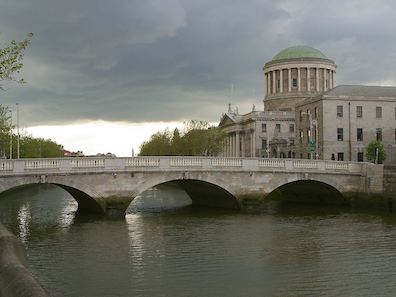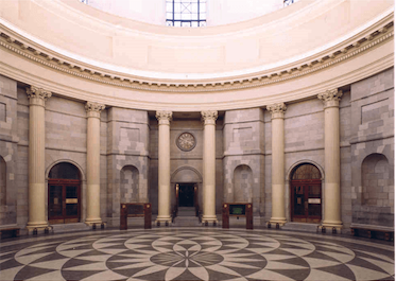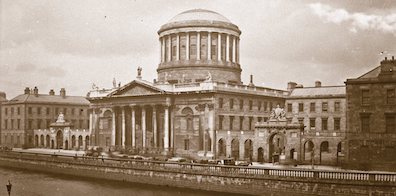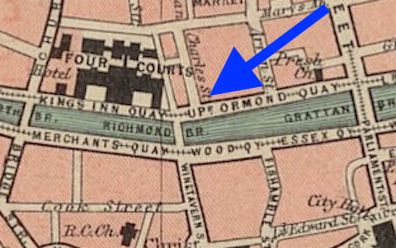Four Courts
Four Courts
In Brief
The "Four Courts" on whose "porch" Richie Goulding stands at
the end of Wandering Rocks is a large neoclassical
structure on the north bank of the Liffey, just west of the
Richmond (now O'Donovan Rossa) Bridge which connects
Winetavern Street on the river's south bank to Chancery Lane
on the north. In 1904 all the superior courts in Ireland were
housed in this building, whose name reflects the fact that it
originally housed four such courts: Chancery, King's Bench,
Exchequer, and Common Pleas. Three different sections of the
tenth chapter show people bustling about at this important
legal center, in a discontinuous sequence that appears to move
forward in time from section to section.
Read More
The name Four Courts goes back to medieval times, when the
courts were independent and competed with one another for
resources and jurisdiction. For many centuries these courts
were located in different places, but in 1776 work began on a
grand structure to bring them together. It was designed first
by Thomas Cooley and, after his death in 1784, by James
Gandon, the architect who designed the Custom House. The new
offices opened for business in 1796. In 1877 the Judicature
Act united the four courts, making them merely divisions of a
single High Court of Justice, but the name has persisted
through this and subsequent organizational changes.
In an interpolated passage in section 9 of Wandering
Rocks lawyers are seen moving between various offices
inside the building: "Lawyers of the past, haughty, pleading,
beheld pass from the consolidated taxing office to Nisi Prius
court Richie Goulding carrying
the costbag of Goulding, Collis and Ward and heard rustling
from the admiralty division of king's bench to the court of
appeal an elderly female with false teeth smiling
incredulously and a black silk skirt of great amplitude."
The "Lawyers of the past" are statues of eminent
lawyers and judges that used to occupy the niches on the
perimeter of the Round Hall, a 64-foot-wide grand entrance
underneath the building's dome where people passing to and
from various offices could cross paths and converse. The
building suffered massive damage at the beginning of the Civil
War of 1922, and today the niches are empty. The Latin phrase
"Nisi Prius" ("unless before," "if not sooner") is a
term in English law that originally referred to the
requirement for a sheriff to bring jurors to court by a
certain day. According to the 11th edition of the Encyclopædia
Britannica (1911), during the 19th century it came to
refer to nearly all cases tried before judges of the King's
Bench court. The text identifies "the admiralty division"
as one branch of that court, as was indeed the case in English
law. The "court of appeal," established by law in 1875,
was a high court that heard appeals from various lower courts.
Richie Goulding is seen passing through the Round Hall from a
taxing office to Nisi Prius court, and an unnamed woman
crosses the same space going from the admiralty court to the
court of appeals.
In the next section, #10, another interpolation returns to
more or less the same scene, but some small amount of time
seems to have passed because the woman is now leaving the
building: "An elderly female, no more young, left the building
of the courts of chancery, king's bench, exchequer and common
pleas, having heard in the lord chancellor's court the case in
lunacy of Potterton, in the admiralty division the summons,
exparte motion, of the owners of the Lady Cairns versus the
owners of the barque Mona, in the court of appeal reservation
of judgment in the case of Harvey versus the Ocean Accident
and Guarantee Corporation." The redundant phrase "elderly
female, no more young," which seems strangely maladroit for
Joyce, perhaps is meant to suggest that the woman has lost her
youth attending to so many legal proceedings.
In this section Joyce somewhat simplifies the bewildering
variety of courts and offices encountered in the previous one
by referring, with characteristic exactitude, to the four
large divisions for which the building was named: "chancery,
king's bench, exchequer and common pleas." The old
woman, it now appears, has been attending not two but three
different court cases: in addition to the hearings in the
admiralty court and the appeals court, she observed one in "the
lord chancellor's court." This was the court of the Lord
Chancellor of Ireland, the country's highest judicial officer.
It appears to have been identical with the Court of Chancery,
though the matter is confusing to this outsider because the
Court of Chancery was technically abolished in 1877, becoming
merely one division of the High Court, and the Lord Chancellor
at that time was given control of the Court of Appeal.
Whatever the specifics of the old woman's courtroom itinerary,
she is now leaving the building, presumably through the grand
central portico on King's Inns (now simply Inns) Quay.
In the final section of the chapter, #19, the viceregal
cavalcade passes this spot in real (i.e., non-interpolated)
time and space, but the time appears to be slightly later than
in the first two passages. Richie Goulding now is standing
amid the columns of the portico on the quay, where the old
woman was before, while she has moved on from that location,
crossing Chancery Lane to the east to visit a solicitor on
Ormond Quay Upper. Both of them see the Lord Lieutenant
passing by on their respective quays: "In the porch of Four
Courts Richie Goulding with the costsbag of Goulding,
Collis and Ward saw him with surprise. Past Richmond
bridge at the doorstep of the office of Reuben J
Dodd, solicitor, agent for the Patriotic Insurance Company,
an elderly female about to enter changed her plan and
retracing her steps by King's windows smiled credulously on
the representative of His Majesty."



